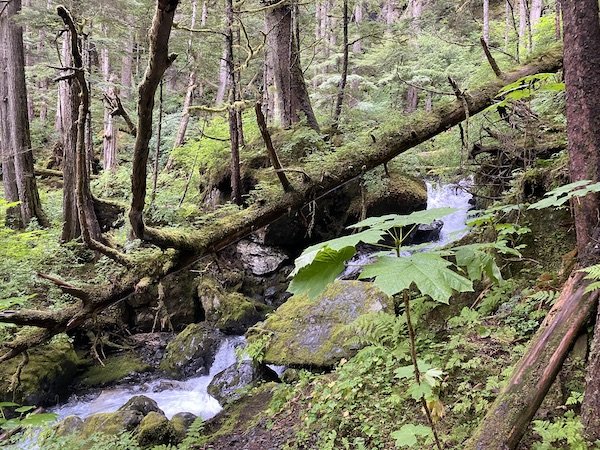The Network Keeps Growing
Dreams are being realized day after day at the Old-Growth Forest Network. On August 10, 2022, one of our biggest dreams was made a reality with the help of the Skagway Traditional Council as we inducted our first Alaska forest, a spectacular section of the Tongass National Forest known as Jánwu Sítʼi, or “Mountain Goat Glacier” in the Tlingit language. This section is also called the Denver Glacier Trail and can be reached by taking the White Pass and Yukon Route (WP&YR) Railroad. The rail line is a narrow-gauge railroad built in 1898 during the Klondike Gold Rush, the WP&YR line is a slice of history and as such, the line is designated as a Civil Engineering Landmark. This is the first OGFN forest to be included in the Network that is accessed primarily via train.
While the beginning of the 3.2-mile trail passes through forests regrown after Gold Rush-era logging, hikers soon enter lush old-growth spruce, cottonwood, and hemlock trees characteristic of the Tongass National Forest’s more northern temperate rainforests. From here, the trail begins to climb more steeply for another 1.5 miles, eventually giving way to a large stand of old-growth spruce and hemlocks until it turns right and heads up to Lower Elway Falls. From the lower falls, you leave the old growth and climb steeply south up the valley through a more immature forest that gives way to thick alder. The upper 2.5 miles of the trail receives little use and is often overgrown with alder and fern. The trail dead ends at the end of a box canyon with spectacular views of the hanging seracs of the Denver Glacier and Upper Elway Falls.
We couldn’t visit spectacular southeastern Alaska and only dedicate one forest! Up next on our Alaskan tour was Beaver Lake/Herring Cove Trail, still within the Tongass National Forest boundaries. The Beaver Lake Trail and Herring Cove Trail join as the paths encircle Beaver Lake, which is surrounded by an impressive stand of old-growth trees. The trails route through forests of western hemlock, Sitka spruce, and yellow cedar, and give opportunities to enjoy far-reaching views, muskegs, and waterfalls. The old-growth forest surrounding Beaver Lake can be enjoyed alongside other recreation opportunities such as fishing and picnicking. Many of the trails that take hikers into this section of forest begin and end in Sitka, a charming community of about 9,000 people that is located southwest of Juneau.
The third and final forest we dedicated during our time in Alaska was the Salmon Lake Trail, a stunning but remote trail located at the southwest end of Silver Bay, about ten miles away from Sitka. Even though it is relatively close to Sitka, Salmon Lake Trail is only accessible via sea taxi, boat, or float plane as there are no roads that connect with the trailhead. The trail follows a steep cliff at the beginning, then opens to a section heavily forested by Sitka spruce, western hemlock, and Alaska yellow cedar. Salmon Lake is about a mile further along the trail and is a great destination for fishing and other recreational opportunities.
The Tongass National Forest in southeastern Alaska was established in 1907 by an executive order issued by President Theodore Roosevelt (formal legislation declaring it a national forest was signed into law in 1909). This forest is historically stewarded by the Tlingit people, whose life and culture rely on these forests, including food, materials for carvings, canoes, weaving, and supporting the intricate webs of biodiversity throughout the Tongass temperate rainforests. Tongass has seen a long line of policy changes, especially over the past 20 years, particularly surrounding the decision to promote or halt building new roads. With each successive presidency since Bill Clinton, the legislature has flip-flopped back and forth between those who would see the roadless protections enforced and those who would promote the continuation of road building. In November of 2021, the Biden Administration published intent to re-establish roadless protections, which went in place after a 60-day period for public comment. It is the largest National Forest, coming in at an impressive 16.7 million acres, and covers much of southeastern Alaska. Tongass is a forest of surprisingly varied terrain, from fjords and glaciers to rushing rivers and craggy peaks of the Coast Mountains, this special forest has a little bit of something for everyone.
Additional Resources
http://www.skagwaytraditional.org
https://en.wikipedia.org/wiki/Tongass_National_Forest#Roadless_controversy





